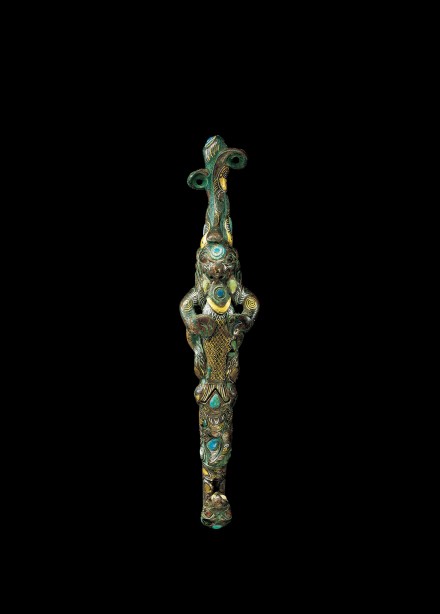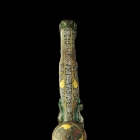J.J. Lally & Co., Oriental Art / New York City, New York
MenuPast Exhibition
Arts of Ancient China
March 27 - April 12, 2006

21.
AN INSCRIBED AND INLAID BRONZE BELTHOOK
Eastern Han-Western Jin Dynasty, A.D. 2nd-3rd Century
cast with a central figure of a four-legged mythical beast with the head of a bird of prey and a single horn rising from its forehead, with its muscular arms ending in large talons grasping a large fish which is separately cast and decorated with a mesh of gold wire ‘scales’ interspersed with silver dots, the hind legs of the beast shown resting at either side of the rounded breast of a dragon with raptor’s head forming the hook, with its partially open beak containing a small pearl, the other end of the belthook curving out to an elaborate tripartite scroll and the underside with a large circular button on a thick stem, the surface richly inlaid with gold and silver spirals and striations all over and inset with chips of turquoise, glass, and agate, the back also richly decorated in gold and silver and with an inscription of twenty seal script characters inlaid in silver wire.
Length 6 1⁄4 inches (15.9 cm)
The inscription on the back of the belthook may be read as wu yue bing wu shen ling qi gou kou han ming zhu shou bao bai yu wei zhi shen zhu which may be translated as "(dedicated on) bing wu (cyclical) date of the fifth month, the mystical spirit hook holds a bright pearl in its mouth, and in its hands grasps a white fish. (may the wearer's position) rise to the highest." Scholars have noted that there is no bing wu day in the Chinese lunar calendar. However, Pang Pu in Wenwu, 1979, No. 6, pp. 81-84 points out that the frequent reference to the four characters wu yue bing wu as inscriptions on bronze garment hooks and mirrors should be understood as a reference to a day when the sun is at its zenith, which is deemed to be the date most auspicious for casting rather than the actual date of production.
Compare also the similar belthook excavated in 1974 in Nanjing from a Western Jin tomb, illustrated in Wenwu, 1976, No. 3, figs. 3 and 16.2, and another closely related belthook excavated in 1968 at Yushuxian, Jilin province, illustrated in Zhongguo Bowuguan Congshu, Jilinsheng Bowuguan (Chinese Museum Series, Jilin Provincial Museum), Vol. 11, Beijing, 1992, pls. 11-12, pp. 163-164, attributed to the Eastern Han dynasty.
An inlaid and inscribed bronze belthook of very similar form and design but of smaller size and with the fish in the center made of ivory, in the Metropolitan Museum of Art, is illustrated by Hearn in Ancient Chinese Art: The Ernest Erickson Collection in the Metropolitan Museum of Art, New York, 1987, p. 59, no. 75. Another example also of smaller size and with a shorter inscription but with the fish made of gold-and-silver-inlaid bronze, from the Collection of Desmond Gure, is illustrated in Asian Art in the Arthur M. Sackler Gallery: The Inaugural Gift, Smithsonian Institute, Washington D.C., 1987, p. 247, no. 164. Another example, of very similar size and design but with severely corroded surface, now in the Musée Guimet, is illustrated by Pirazzoli-t’Serstevens in The Han Dynasty, New York, 1982, p. 189, no. 150. Two other examples, also very corroded, are illustrated by Karlgren in “Chinese Agraffes in Two Swedish Collections”, Bulletin of the Museum of Far Eastern Antiquities, no. 38, Stockholm, 1966, pl. 66, nos. O38 and O39.
東漢/西晉 錯金銀銘文銅帶鉤 長 15.9 厘米
Additional Images (Touch to enlarge)
21.
AN INSCRIBED AND INLAID BRONZE BELTHOOK
Eastern Han-Western Jin Dynasty, A.D. 2nd-3rd Century
Length 6 1⁄4 inches (15.9 cm)
